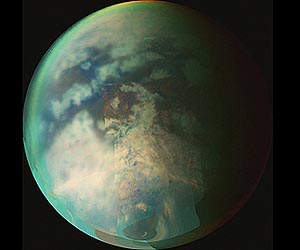The Cassini spacecraft recently uncovered evidence that implies the possible existence of an underground ocean of water and ammonia on Saturn's moon, Titan. In fact, Titan has been characterized as having one of the most Earth-like surfaces in the Solar System.
 If the TiME mission is flown, it may provide the first direct exploration of an ocean environment beyond Earth. The objective is to send a spacecraft to Titan which would release a lander probe. However, this probe would be like a boat, since it must float on a large methane-ethane sea.
If the TiME mission is flown, it may provide the first direct exploration of an ocean environment beyond Earth. The objective is to send a spacecraft to Titan which would release a lander probe. However, this probe would be like a boat, since it must float on a large methane-ethane sea.
In addition, the presence of an underground sea on Titan was deduced from the odd rotational dynamics of Saturn's largest moon.
Titan is larger than Mercury, but it is the only known celestial body besides Earth to have liquid on its surface. However, unlike Earth, Titan's seas are made of liquid methane instead of water.
On Earth, methane is a flammable gas, but Titan has no oxygen in its atmosphere that could support combustion.
Also, the temperatures on Titan are much colder than here, at about - 300o F. So methane occurs in liquid form. Scientists believe Titan's landscape includes fluvial, river-like features that may well have been formed by methane rain. Furthermore, there is speculation that this environment might host life forms.
To increase the mystery, Titan might also contain an internal ocean of water and ammonia. Based on radar scanning through Titan's dense atmosphere, the Cassini spacecraft found that a number of prominent surface features had shifted their positions by up to 19 miles over a period of time.
One conclusion is that the crust is moving and may be resting on liquid.
Results from Titan have encouraged the possible investigation of liquid on other bodies, such as Jupiter's four largest satellites, the Galilean moons (Io, Europa, Ganymede and Callisto). This is exciting science and hopefully NASA will be able to explore the many possibilities for extraterrestrial life in the Solar System.